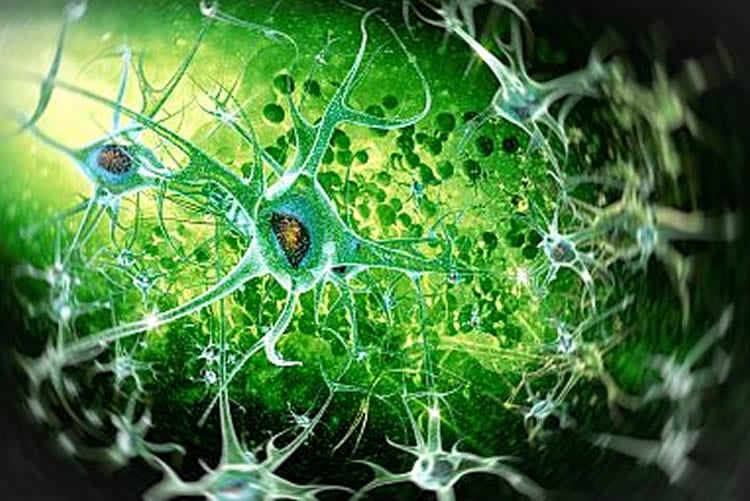Summary: Researchers have identified a set of heat sensing neurons that prompt both nervous system and behavioral changes that help cool the body.
Source: NIH.
The body’s temperature is closely regulated. We sense temperature changes in the environment through specialized nerve cells in the outer layers of the skin. If we are too hot or too cold, our nervous system activates responses to help change our temperature. We can sweat to cool down or shiver to generate heat. Our blood vessels can constrict to conserve heat or expand to release heat. To avoid discomfort, we sometimes seek out different environments―choosing to go into an air conditioned room or sit by a heater.
Exactly how our brains turn on these regulating systems and behaviors isn’t clear. A research team led by Dr. Zachary Knight at the University of California, San Francisco, searched for neurons that detect body temperature changes in the brain region that regulates nervous system functions like temperature and sleep: the preoptic area of the hypothalamus. The research was funded in part by NIH’s National Institute of Diabetes and Digestive and Kidney Diseases (NIDDK) and National Institute of Neurological Disorders and Stroke (NINDS). Results were published in Cell on September 22, 2016.
Using a technique called phosphoTRAP, the researchers identified genes that were activated when mice were exposed to warm temperatures. They found a unique population of heat-sensitive brain cells that expressed high levels of neuropeptides called PACAP and BDNF. The team measured these cells’ activities while mice were exposed to temperature increases (from 25°C to 45°C) and decreases (from 25°C to 10°C) in a custom-built chamber. The specialized neurons were activated by warm temperatures, but not by cool temperatures.
The scientists genetically inserted a light-responsive protein into the specialized cells to control their activity. This allowed the researchers to turn on the heat-sensing neurons using a fiber-optic light. When the cells were activated, the animals’ core body temperatures dropped. Blood vessels in the animals’ tails dilated to release heat, and fat-burning heat production decreased. The mice also spontaneously moved to a colder part of the chamber, suggesting that activation of these neurons can induce both nervous system and behavioral changes that reduce the body’s temperature.

Using imaging techniques, the researchers confirmed that the heat-sensing neurons reach into brain regions that control both nervous system responses and motivated behaviors. These specialized brain cells could be activated by stimulating heat-sensitive nerve cells in the animals’ skin, suggesting that the neurons use the body’s peripheral temperature sensors for heat detection.
“We know a lot about how body temperature is regulated in peripheral tissues, and a bit about the key regulatory brain regions, but the identity of the neurons that act as the master regulators of body temperature has been elusive,” says Knight. The authors suggest that specific sets of heat and cold-sensing neurons sit within in the preoptic area to act as a central control center for body temperature; however, more research is needed to determine if such cold-sensitive cells also exist.
Funding: NIH New Innovator Award, NIH Common Fund, NIH’s National Institute of Diabetes and Digestive and Kidney Diseases (NIDDK) and National Institute of Neurological Disorders and Stroke (NINDS).
Source: Tianna Hicklin – NIH
Image Source: NeuroscienceNews.com image is adapted from the NIH press release.
Original Research: Abstract for “Warm-Sensitive Neurons that Control Body Temperature” by Chan Lek Tan, Elizabeth K. Cooke, David E. Leib, Yen-Chu Lin, Gwendolyn E. Daly, Christopher A. Zimmerman, and Zachary A. Knight in Cell. Published online September 8 2016 doi:10.1016/j.cell.2016.08.028
[cbtabs][cbtab title=”MLA”]NIH “Brain Cells That Cool the Body.” NeuroscienceNews. NeuroscienceNews, 5 October 2016.
<https://neurosciencenews.com/thermoregulation-neuroscience-5210/>.[/cbtab][cbtab title=”APA”]NIH (2016, October 5). Brain Cells That Cool the Body. NeuroscienceNew. Retrieved October 5, 2016 from https://neurosciencenews.com/thermoregulation-neuroscience-5210/[/cbtab][cbtab title=”Chicago”]NIH “Brain Cells That Cool the Body.” https://neurosciencenews.com/thermoregulation-neuroscience-5210/ (accessed October 5, 2016).[/cbtab][/cbtabs]
Abstract
Warm-Sensitive Neurons that Control Body Temperature
Highlights
•Preoptic neurons co-expressing BDNF/PACAP are rapidly activated by ambient warmth
•Stimulation of these warm-sensitive neurons (WSNs) rapidly reduces body temperature
•WSNs activate a coordinated program of autonomic and behavioral responses to heat
•WSN projections delineate the structure of the downstream thermoregulatory circuit
Summary
Thermoregulation is one of the most vital functions of the brain, but how temperature information is converted into homeostatic responses remains unknown. Here, we use an unbiased approach for activity-dependent RNA sequencing to identify warm-sensitive neurons (WSNs) within the preoptic hypothalamus that orchestrate the homeostatic response to heat. We show that these WSNs are molecularly defined by co-expression of the neuropeptides BDNF and PACAP. Optical recordings in awake, behaving mice reveal that these neurons are selectively activated by environmental warmth. Optogenetic excitation of WSNs triggers rapid hypothermia, mediated by reciprocal changes in heat production and loss, as well as dramatic cold-seeking behavior. Projection-specific manipulations demonstrate that these distinct effectors are controlled by anatomically segregated pathways. These findings reveal a molecularly defined cell type that coordinates the diverse behavioral and autonomic responses to heat. Identification of these warm-sensitive cells provides genetic access to the core neural circuit regulating the body temperature of mammals.
“Warm-Sensitive Neurons that Control Body Temperature” by Chan Lek Tan, Elizabeth K. Cooke, David E. Leib, Yen-Chu Lin, Gwendolyn E. Daly, Christopher A. Zimmerman, and Zachary A. Knight in Cell. Published online September 8 2016 doi:10.1016/j.cell.2016.08.028






